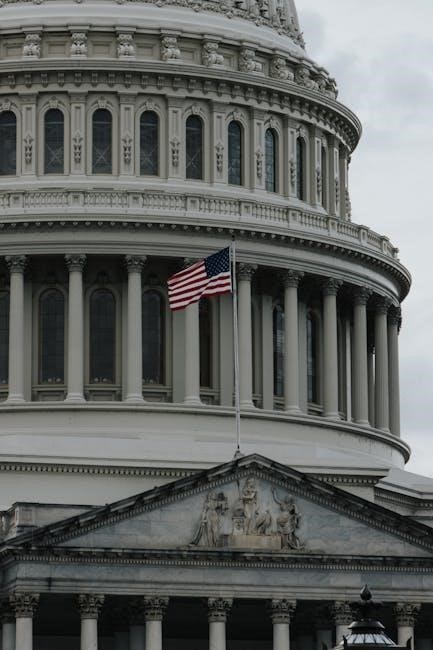foundations of government worksheet pdf
Understanding the foundations of government is crucial for grasping its role in society. This section explores the essential principles, structures, and systems that shape governance, ensuring order and individual freedoms.
Overview of Government Basics
Government basics involve understanding the fundamental principles and structures that define how a nation operates. This includes the division of power through federalism, separation of powers, and checks and balances. Essential features of a state, such as population, territory, sovereignty, and government, are also key. These concepts form the backbone of governance, ensuring order, stability, and the protection of individual rights. Studying these basics provides a foundation for analyzing how governments function and evolve over time.
Importance of Understanding Government Foundations
Understanding government foundations is vital for fostering informed citizenship and civic engagement. It equips individuals with knowledge of principles like federalism, separation of powers, and checks and balances, which prevent power abuse. Recognizing these elements helps citizens grasp how governments maintain order and protect freedoms. This understanding promotes critical thinking about governance and its impact on society, enabling individuals to contribute meaningfully to democratic processes and advocate for their rights effectively.

Key Principles of Government
Key principles include democracy, rule of law, accountability, transparency, limited government, and control of power abuse. These principles ensure fairness, stability, and protection of individual rights.
Democracy and Citizen Participation
Democracy relies on citizen participation through free and fair elections, ensuring representation and accountability. It emphasizes rule of law, majority rule with minority rights, and transparency. Citizens engage by voting, debating, and holding leaders accountable, fostering a system where power derives from the people. This principle ensures governance reflects public will, protecting individual freedoms and promoting equality. Active participation strengthens democratic institutions and maintains trust in government processes.
Rule of Law and Its Significance
The rule of law ensures that all individuals and institutions, including government, are governed by a set of established laws. It promotes accountability, transparency, and justice, safeguarding individual rights. This principle is fundamental to democracy, as it prevents arbitrary power and ensures equality before the law. By adhering to the rule of law, governments maintain legitimacy and trust, fostering a stable and just society where freedoms are protected and order is maintained effectively.
Accountability and Transparency in Governance
Accountability ensures that government officials are responsible for their actions, while transparency involves openness in decision-making processes. These principles are vital for trust and fairness in governance; They prevent corruption and abuse of power by ensuring that actions are visible and justifiable. Mechanisms like checks and balances, free press, and public oversight uphold accountability and transparency, fostering a system where power is exercised responsibly and in the public interest, protecting individual rights and promoting justice.
Limited Government and the Bill of Rights
Limited government ensures that power is restricted to prevent abuse, safeguarding individual freedoms. The Bill of Rights, part of the U.S. Constitution, guarantees fundamental liberties such as free speech and due process. These principles protect citizens from overreach, ensuring that government authority remains bounded by law. The Framers designed this system to balance power and secure rights, fostering a framework where government serves the people while respecting their autonomy and dignity, as outlined in foundational documents like the Constitution.
Control of the Abuse of Power
Controlling the abuse of power is essential to maintaining a just and fair system of governance. The Framers implemented mechanisms such as checks and balances and separation of powers to prevent any single entity from dominating. These systems ensure accountability and transparency, safeguarding against tyranny. By dividing authority and providing oversight, governments can protect individual rights and maintain public trust, ensuring that power remains a tool for the common good rather than a means of oppression or exploitation.
Economic Freedom and Its Role
Economic freedom is a cornerstone of a thriving society, enabling individuals and businesses to operate with minimal government interference. It fosters innovation, entrepreneurship, and personal prosperity. Governments play a crucial role in protecting property rights, enforcing contracts, and maintaining a stable economic environment. By promoting free markets and fair competition, economic freedom empowers citizens and drives national growth. This principle is essential for ensuring prosperity and maintaining a high standard of living, aligning with the broader goals of governance and societal well-being.
Equality in Government Systems
Equality is a fundamental principle in government systems, ensuring that all individuals are treated fairly and without discrimination. It promotes justice, inclusivity, and equal opportunities for all citizens. Governments must uphold laws that protect civil rights and prevent bias, fostering a society where everyone can thrive. By embedding equality in policies and practices, governments create a balanced framework that respects diversity and supports the well-being of all people, ensuring a just and equitable society for future generations.
Individual Rights and Human Rights
Individual rights and human rights are cornerstone principles in democratic governance, ensuring personal freedoms and protections. These rights include freedom of speech, religion, and assembly, as well as protections from discrimination and unjust treatment. Governments are tasked with safeguarding these rights through laws and policies, ensuring that all citizens are treated with dignity and respect. By upholding these principles, governments foster a just and equitable society where individuals can thrive and contribute to the common good.
Theories of Government Origin
Scholars have developed key theories to explain the origins of governments, shaping societal structures and systems. These theories provide insights into how governments evolve and function today.
Key Theories Explaining Government Origins
Scholars have identified four primary theories explaining the origins of governments: the Divine Right of Kings, Social Contract, Evolutionary Theory, and the Force Theory. These theories explore how governments arose to maintain order, protect rights, and fulfill societal needs. The Divine Right theory posits that rulers derive authority from God, while the Social Contract theory emphasizes voluntary agreements among individuals. Evolutionary Theory suggests gradual development, and the Force Theory attributes government origins to power consolidation. These concepts are essential for understanding governance foundations and are often explored in educational resources like the foundations of government worksheet PDF.

Federalism: Division of Power
Federalism establishes a balance of power between federal and state governments, ensuring national unity while allowing local governance. This division prevents centralized authority and promotes accountability.
Federal Structure and Its Benefits
A federal structure divides power between national and state governments, ensuring a balance that prevents centralized authority. This system allows the federal government to address national issues while states manage local matters, fostering accountability and efficiency. By delegating responsibilities, federalism ensures that decisions are made at the most appropriate level, promoting unity while respecting regional diversity. This structure is a cornerstone of democratic governance, enabling effective management of diverse societal needs while safeguarding individual freedoms and rights.
Responsibilities of National and State Governments
The national government oversees issues affecting the entire nation, such as foreign policy, defense, and interstate commerce. State governments manage local matters like education, transportation, and public safety. This division ensures efficient governance, allowing each level to focus on its strengths while maintaining accountability. Federalism promotes unity by addressing shared needs while respecting regional differences, ensuring a balanced and responsive system that protects individual rights and freedoms. This structure is vital for maintaining order and prosperity in a diverse society.
Separation of Powers
The separation of powers divides government functions among the legislative, executive, and judicial branches. This system prevents power abuse and ensures accountability, protecting individual rights and freedoms.
Division of Functions Among Three Branches
The separation of powers divides government functions into three branches: legislative, executive, and judicial. The legislative branch creates laws, the executive enforces them, and the judicial interprets them. This division ensures no single branch dominates, preventing abuse of power. It promotes accountability and protects individual rights, maintaining a balance essential for a fair and functional government system. This structure is a cornerstone of democratic governance, fostering stability and justice.

Checks and Balances in Government
Checks and balances ensure no branch of government exceeds its authority. Each branch can limit the actions of the others, preventing power concentration and protecting liberties.
Mechanisms to Prevent Power Abuse
Key mechanisms include checks and balances, separation of powers, and federalism. These systems ensure no single entity dominates, safeguarding against abuse. Checks and balances allow branches to limit each other, while federalism divides power between national and state governments. Such structures prevent concentration of authority, protecting individual rights and promoting accountability. These mechanisms are fundamental to maintaining a just and equitable governance system, as outlined in foundational documents like the U.S. Constitution.

Essential Features of a State
A state is defined by four key characteristics: population, territory, sovereignty, and government. These elements ensure stability, legitimacy, and the ability to provide public services effectively.
Key Characteristics Defining a State
A state is defined by four essential features: population, territory, sovereignty, and government. These elements ensure its legitimacy and ability to function effectively. The population refers to its permanent residents, while territory is a clearly defined area. Sovereignty grants the state supreme authority over its affairs, and government provides the framework for governance; Together, these characteristics establish a state’s identity and enable it to maintain order and provide services to its citizens.

Economic Systems and Government Interaction
Governments play a crucial role in guiding economic systems through regulations, policies, and public services, ensuring stability and growth while addressing societal needs and market demands effectively.
Understanding the U.S. Economy and Government Role
The U.S. economy is a mixed system blending free enterprise with government regulation. The government plays a vital role in stabilizing the economy through fiscal and monetary policies, infrastructure development, and social welfare programs. It ensures fair competition, protects consumer rights, and addresses market failures. By regulating financial institutions and enforcing laws, the government balances economic freedom with public interest, fostering growth while safeguarding societal needs. This interaction is fundamental to maintaining a stable and prosperous economic environment.

Systems of Government
Government systems include democracy, authoritarianism, and hybrid models. Each system defines power distribution, citizen participation, and governance structures, shaping how authority is exercised and legitimacy is maintained.
Major Types of Government Systems
Major government systems include democracy, authoritarianism, and hybrid models. Democracies emphasize citizen participation and free elections, while authoritarian systems concentrate power with limited citizen input. Hybrid systems blend elements of both. Federalism, a key feature in some democracies, divides power between national and state governments. These systems shape how authority is exercised, influencing governance, individual freedoms, and societal structures. Understanding these types is essential for analyzing how governments function and evolve, as explored in the foundations of government worksheet.

Principles of Democracy
Democracy relies on citizen participation, free elections, rule of law, and protection of minority rights. It ensures accountability, transparency, and limits on power to safeguard individual freedoms and justice.
Core Values and Practices in Democratic Systems
Democratic systems are built on core values like citizen participation, free and fair elections, and the rule of law. These systems ensure accountability and transparency, protecting minority rights while upholding majority rule. Practices include regular elections, freedom of speech, and an independent judiciary. These principles foster trust, equality, and justice, ensuring that power remains limited and distributed fairly. They are essential for maintaining stability and promoting the well-being of all citizens in a democratic society.
Authoritarian Government Principles
Authoritarian systems emphasize centralized power, limited citizen participation, and strict control over society. They often suppress dissent and prioritize state authority over individual freedoms and rights.
Key Characteristics of Authoritarian Systems
Authoritarian systems are defined by centralized power, suppression of dissent, and limited political opposition. They often prioritize state control over individual freedoms, with power concentrated in a single leader or party. These systems frequently restrict civil liberties, limit free media, and suppress opposition through surveillance or force. Citizen participation in governance is minimal, and the rule of law may be undermined to maintain authority. Authoritarian regimes emphasize stability and order, often at the expense of democratic principles and human rights.

The Preamble of the U;S. Constitution
The Preamble outlines the Constitution’s purpose, aiming to establish justice, ensure tranquility, and secure liberty for all citizens, forming the foundation of U.S. governance and ideals.
Relevance and Purpose Today
The Preamble remains a cornerstone of U.S. governance, guiding principles of justice, unity, and liberty. Its purpose today is to ensure the Constitution’s goals are upheld, reflecting enduring values. Educational tools, like worksheets, help students analyze its relevance, connecting historical intent to modern governance; This fosters understanding of how the Preamble shapes democracy, emphasizing its ongoing importance in maintaining order and freedom.

Worksheet Activities and Exercises
Engage with foundational concepts through guided reading and interactive exercises, analyzing the Preamble and comparing government systems to deepen understanding of civic principles and structures effectively.
Analyzing the Preamble
The Preamble outlines the Constitution’s purpose, emphasizing justice, tranquility, and liberty. Worksheets guide students to evaluate its relevance today, connecting its principles to modern governance. Activities include analyzing the Framers’ intent to maintain order while ensuring freedom, fostering critical thinking about foundational values and their enduring impact on society. These exercises help students understand how the Preamble’s goals shape the government’s role in addressing national issues and safeguarding individual rights, bridging historical context with contemporary applications.
Comparative Analysis of Government Systems
Comparative analysis of government systems involves examining their structures, principles, and functions. Worksheets guide students to compare democracies and authoritarian regimes, focusing on key features like citizen participation, rule of law, and power distribution. Activities encourage critical thinking about how different systems address individual rights, economic freedom, and equality. By evaluating these elements, students gain insights into the strengths and weaknesses of various governance models, fostering a deeper understanding of global political dynamics and their impact on societies.
Guided Reading and Study Materials
Guided reading activities and worksheets provide structured learning tools, helping students engage with foundational concepts. Resources include PDFs, workbooks, and exercises for effective civic education and understanding.
Resources for Effective Learning
Free printable worksheets and workbooks on the foundations of government are available for download, offering structured activities for students. These resources cover topics like the Preamble, federalism, and economic systems, providing engaging exercises to enhance understanding. Designed for middle and high school classrooms, they include guided reading materials, puzzles, and comparative analyses. Educators can use these tools to foster critical thinking and civic awareness, ensuring students grasp key concepts effectively. Downloadable PDFs make it easy to integrate these resources into lesson plans.
Importance of Civics Education
Civics education fosters informed, engaged citizens by teaching government foundations, rights, and responsibilities. It promotes critical thinking and active participation in shaping society, ensuring democratic values endure.
Cultivating Informed and Engaged Citizens
Civics education empowers individuals to understand their rights and responsibilities, fostering active participation in democracy. Through interactive tools like the foundations of government worksheet PDF, students engage with key concepts such as federalism, the Constitution, and democratic principles. These resources provide hands-on learning experiences, enabling learners to connect theoretical knowledge with practical applications. By equipping citizens with a strong foundation in governance, society ensures the continuation of informed decision-making and civic responsibility, vital for a thriving democracy.
Understanding government foundations is essential for informed citizenship. Tools like the foundations of government worksheet PDF enhance learning, ensuring citizens grasp key principles and their roles in democracy.
The foundations of government revolve around principles like democracy, rule of law, and accountability. Federalism divides power between national and state governments, while separation of powers and checks and balances prevent abuse. Essential features of a state include sovereignty and territory. Tools like the foundations of government worksheet PDF help students analyze these concepts, fostering civic literacy and critical thinking about governance structures and their role in maintaining order and freedom.
Final Thoughts on Government Foundations
Understanding the foundations of government is vital for fostering informed citizenship. Key concepts like federalism, separation of powers, and checks and balances ensure power remains balanced. Tools such as the foundations of government worksheet PDF provide interactive learning opportunities, helping students grasp these principles. By studying these fundamentals, individuals can better appreciate how governments maintain order while protecting individual freedoms, ensuring a stable and just society for future generations.
